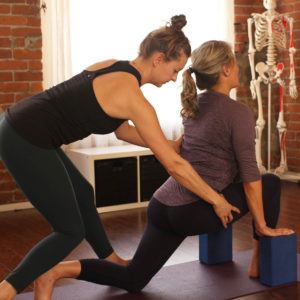
This article addresses some misconceptions around pelvic health and yoga ahead of our weekend workshop Yoga & Pelvic Health on April 4-5 with Certified Yoga Therapist Chelsea Lee.
The course is open to everybody interested in learning about pelvic health and yoga. It is designed to help yoga instructors cue their students to engage their pelvic floor muscles (PFM) during yoga classes, as well as explore various asana beneficial for lengthening & relaxing the PFM.
Improving Pelvic Health Through Yoga
Through yoga, we are able to increase body awareness through self learning and self study. This can benefit us when looking at pelvic health. For example, we can explore the difference between various types of contractions and relaxations in our own bodies, before instructing others.
In the Yoga & Pelvic Health course, participants will gain a deeper understanding of their own anatomy through an exploration into how skeletal alignment (the position of your bones) will alter your ability to activate & relax the pelvic floor muscles, as well as its relationship to breathing (a task that we have been performing since the day we were born!)
When applying knowledge of pelvic anatomy into yoga, it’s important to look at the implications with breathing. Breathing is an essential task for the body. We breathe constantly throughout the day (hopefully!) and the way you breathe impacts what happens throughout your body
After examining the impacts of breathing by looking at breathing mechanics, it’s possible to then layer that knowledge when offering different asana.
For example: when directing the way you breathe, while simultaneously contracting different layers of the pelvic floor, how does this change the stability you experience in one legged standing? How does activating or relaxing different muscles change the feeling of steadiness and ease?
The Relationship Between the Hips and Pelvis
The phrase ‘hip openers’ is a bit of a misnomer in yoga. The hip is a joint and joints never literally open. Openness is metaphorical, poetic language, often used to mean “lengthening” or “stretching”. The “hip opener” classification in asana is often reserved for postures such as pigeon and thread the needle (postures with external rotation of one or both legs). However, any asana that changes the position of the joint (from anatomical neutral) could be classified as a hip “opener” as you are lengthening tissues around the hip – which is most asana!.
The deep external rotators of the hip are fascially connected to the muscles of the pelvic floor. Therefore, there is a strong relationship between the pelvic girdle and the hip joints. This is an important piece to integrate because many of us complain of hip pain and tension, and yet fail to look at the role the pelvic floor plays in that tension. Is this hip driven tension? Or pelvic floor driven tension? That said, it could be a compensation for something occurring elsewhere in the body, as well! The idea is to look at yourself as a whole and become less symptoms focused because those symptoms could be caused by something else.
Knowledge is empowering. Learning about your body allows you the opportunity to become the expert of your experience. While we must rely on the expertise and training of professionals for various assessments and diagnoses, we must also take on the challenge of deepening our own understanding of what’s going on in the body. This awareness and knowledge will empower you to change the way you move and breathe throughout your day in order to make lasting change in the steadiness, ease and harmony you feel.
Kegels aren’t always the answer!
Kegel exercises were invented by Arnold Henry Kegel, an American gynecologist who first published his ideas in 1948. Kegel exercises involve contracting the muscles of the pelvic floor and are widely used today to treat urinary incontinence and pelvic organ prolapse.
One of the most important myths to dispel is that kegels will help with all pelvic floor problems. The pelvic floor does not always need more strength and tone. For example, there can be many causes of urinary incontinence – a “weak” pelvic floor is just one of them. Kegels aren’t always the answer for urinary incontinence! Many people are now gripping through their pelvic floor throughout the day and are unable to move well in a lot of postures and daily tasks. This can result in many issues to arise, including hip tension/pain & knee pain.
Before undertaking or prescribing any exercise, more in-depth knowledge around the pelvic girdle & floor is required. Like any muscle in the body, it’s important to be able to both engage and relax the three muscular layers of your pelvic floor. Awareness and understanding are key – do you need more tone or more relaxation, and during which activities?
The “Core”
The pelvic floor muscles are a part of your “core”. But what are we really talking about when we say “engage your core” (a cue that is given in many yoga classes without clear instruction of how to do it)?
The core refers to a region of the body that is shaped like a canister. Forming the top of the core is the thoracic/respiratory diaphragm (your primary breathing muscle), the front and sides is your transverse abdominis, the back part of the core is the deep multifidus, while the bottom is the pelvic diaphragm/floor.
This three dimensional view of the core suggests that it is impacted by literally all movement and every breath that you take. Healthy functioning requires equal support, strength and stability from all sides.
Diagnosing Pelvic Health Conditions
Quite often, the symptoms do not provide all of the information. It’s never enough to take a symptom such as hip pain and say “this is the exercise or asana for you!” One needs to look more thoroughly into what is driving the issue / causing the symptom to occur.
Those who take the Yoga & Pelvic Health course will not learn to diagnose pelvic health conditions. Yoga professionals such as yoga teachers or yoga therapists must rely on the expertise of healthcare professionals for diagnosis. If a student or client is experiencing any pelvic girdle pain, incontinence or other pelvic health conditions, it’s important that they seek the expertise of a healthcare practitioner, such as a pelvic floor physiotherapist for examination & assessment.
Begin your journey in yoga therapy.
I’d like more information first.
I’d like to come see the school!
Am I eligible to enrol?
Read more yoga therapy stories.





